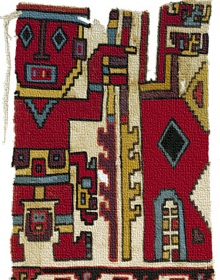let the objects speak
Moche - Textile Fragment - In the Object's Own Words

Form
Due to the poor preservation of textiles in the region, the people who made me, the Moche, are better known for their beautiful ceramic works. However, the skills required to make me had been developed much earlier and passed down from weaver to weaver for much longer than the skills of potters.
Around A.D. 650-850 a Moche artisan wove me using a design that includes imagery associated with the Wari people. I was made during a time period known to have been dominated by the Wari. Their homeland was in the central highlands but their influence spread throughout much of the land that is now called Peru.
Function
While my images are those of the Wari people, my structure indicates that I was made on the coast using the techniques characteristic of the politically independent Moche. Many of the garments made in the Wari highlands were made entirely of wool, as the camelids that provided the raw material for the yarn thrived best when tended at those high elevations. However, as you can see, my ground cloth is all cotton, a plant that grows best at lower elevations like those of the coast.
While my people had access to cotton locally, they still imported great amounts of wool from the highlands for textile production. Wool can be dyed more vibrantly and in many more colours than cotton so woolen yarn became an essential raw material in all of the fine ancient Peruvian weaving traditions, regardless of the distance from camelid herds.
Interment
In Moche society, my kind of fine cloth served as a symbol of rank and prestige. High status individuals wore garments requiring great skill to produce, with elaborate patterns rich in colour and design. These textiles were later incorporated into burial ceremonies of the deceased. Even fancier than me were Moche textiles covered with shimmering plates of gold and silver, or with other valuable materials such as the iridescent feathers of jungle birds.
My people built immense huacas (pyramids) out of millions of adobe bricks, such as the Huaca de la Luna pictured left. The largest of these was the Huaca del Sol which was the seat of the powerful Moche imperial government and a place of importance for many centuries. It is likely that the Moche rulers were buried within this great structure.
Rediscovery
Recently, there has been a development that allows my colourful youth to be recaptured. My people used natural dyes made of plants, minerals, and even insects to colour the fibres in their textiles. Over the centuries, as textiles like me age, our colours fade and change. As you can see, my red, yellow, black and purple dyed threads have fared pretty well over time, although some parts of me are more faded than others. I used to have a great deal more blue thread woven into me, but for some reason, the dyes or mordants used to colour my blue threads caused more degradation than those used to make other colours.
However, now that a picture of me can be scanned into a computer, it is possible to restore much of my colour and brilliance to a level consistent with my best preserved sections. Now you can see that the Moche, like other coastal Andean people, preferred bright colours with high contrasts on their textiles!